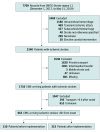Prehospital Comprehensive Stroke Center vs Primary Stroke Center Triage in Patients With Suspected Large Vessel Occlusion Stroke
- PMID: 34369969
- PMCID: PMC8353578
- DOI: 10.1001/jamaneurol.2021.2485
Prehospital Comprehensive Stroke Center vs Primary Stroke Center Triage in Patients With Suspected Large Vessel Occlusion Stroke
Abstract
Importance: Endovascular therapy (EVT) improves functional outcomes in acute ischemic stroke (AIS) with large vessel occlusion (LVO). Whether implementation of a regional prehospital transport policy for comprehensive stroke center triage increases use of EVT is uncertain.
Objective: To evaluate the association of a regional prehospital transport policy that directly triages patients with suspected LVO stroke to the nearest comprehensive stroke center with rates of EVT.
Design, setting, and participants: This retrospective, multicenter preimplementation-postimplementation study used an interrupted time series analysis to compare treatment rates before and after implementation in patients with AIS arriving at 15 primary stroke centers and 8 comprehensive stroke centers in Chicago, Illinois, via emergency medical services (EMS) transport from December 1, 2017, to May 31, 2019 (9 months before and after implementation in September 2018). Data were analyzed from December 1, 2017, to May 31, 2019.
Interventions: Prehospital EMS transport policy to triage patients with suspected LVO stroke, using a 3-item stroke scale, to comprehensive stroke centers.
Main outcomes and measures: Rates of EVT before and after implementation among EMS-transported patients within 6 hours of AIS onset.
Results: Among 7709 patients with stroke, 663 (mean [SD] age, 68.5 [14.9] years; 342 women [51.6%] and 321 men [48.4%]; and 348 Black individuals [52.5%]) with AIS arrived within 6 hours of stroke onset by EMS transport: 310 of 2603 (11.9%) in the preimplementation period and 353 of 2637 (13.4%) in the postimplementation period. The EVT rate increased overall among all patients with AIS (preimplementation, 4.9% [95% CI, 4.1%-5.8%]; postimplementation, 7.4% [95% CI, 7.5%-8.5%]; P < .001) and among EMS-transported patients with AIS within 6 hours of onset (preimplementation, 4.8% [95% CI, 3.0%-7.8%]; postimplementation, 13.6% [95% CI, 10.4%-17.6%]; P < .001). On interrupted time series analysis among EMS-transported patients, the level change within 1 month of implementation was 7.15% (P = .04) with no slope change before (0.16%; P = .71) or after (0.08%; P = .89), which indicates a step rather than gradual change. No change in time to thrombolysis or rate of thrombolysis was observed (step change, 1.42%; P = .82). There were no differences in EVT rates in patients not arriving by EMS in the 6- to 24-hour window or by interhospital transfer or walk-in, irrespective of time window.
Conclusions and relevance: Implementation of a prehospital transport policy for comprehensive stroke center triage in Chicago was associated with a significant, rapid, and sustained increase in EVT rate for patients with AIS without deleterious associations with thrombolysis rates or times.
Conflict of interest statement
Figures


Similar articles
-
Prehospital Triage Strategies for the Transportation of Suspected Stroke Patients in the United States.Stroke. 2020 Nov;51(11):3310-3319. doi: 10.1161/STROKEAHA.120.031144. Epub 2020 Oct 7. Stroke. 2020. PMID: 33023425 Free PMC article.
-
Utility of Severity-Based Prehospital Triage for Endovascular Thrombectomy: ACT-FAST Validation Study.Stroke. 2021 Jan;52(1):70-79. doi: 10.1161/STROKEAHA.120.031467. Epub 2020 Dec 22. Stroke. 2021. PMID: 33349016
-
Implementation of a Prehospital Stroke Triage System Using Symptom Severity and Teleconsultation in the Stockholm Stroke Triage Study.JAMA Neurol. 2020 Jun 1;77(6):691-699. doi: 10.1001/jamaneurol.2020.0319. JAMA Neurol. 2020. PMID: 32250423 Free PMC article.
-
Detection of Large Vessel Occlusion Stroke in the Prehospital Setting: Electroencephalography as a Potential Triage Instrument.Stroke. 2021 Jul;52(7):e347-e355. doi: 10.1161/STROKEAHA.120.033053. Epub 2021 May 4. Stroke. 2021. PMID: 33940955 Review.
-
Pathway Design for Acute Stroke Care in the Era of Endovascular Thrombectomy: A Critical Overview of Optimization Efforts.Stroke. 2020 Nov;51(11):3452-3460. doi: 10.1161/STROKEAHA.120.030392. Epub 2020 Oct 19. Stroke. 2020. PMID: 33070713 Review.
Cited by
-
Comparison of prehospital stroke assessment scales for acute ischemic stroke with large vessel occlusion within six hours of onset: A single-center study in Eastern Taiwan.Tzu Chi Med J. 2024 Nov 27;37(3):311-320. doi: 10.4103/tcmj.tcmj_191_24. eCollection 2025 Jul-Sep. Tzu Chi Med J. 2024. PMID: 40741612 Free PMC article.
-
Impact of interhospital transfer vs. direct admission on acute ischemic stroke patients: A subset analysis of the COMPLETE registry.Front Neurol. 2022 Aug 9;13:896165. doi: 10.3389/fneur.2022.896165. eCollection 2022. Front Neurol. 2022. PMID: 36016541 Free PMC article.
-
Women With Large Vessel Occlusion Acute Ischemic Stroke Are Less Likely to Be Routed to Comprehensive Stroke Centers.J Am Heart Assoc. 2023 Jul 18;12(14):e029830. doi: 10.1161/JAHA.123.029830. Epub 2023 Jul 18. J Am Heart Assoc. 2023. PMID: 37462071 Free PMC article.
-
Heart Disease and Stroke Statistics-2023 Update: A Report From the American Heart Association.Circulation. 2023 Feb 21;147(8):e93-e621. doi: 10.1161/CIR.0000000000001123. Epub 2023 Jan 25. Circulation. 2023. PMID: 36695182 Free PMC article. Review.
-
Association of Medicare-Medicaid Dual Eligibility and Race and Ethnicity With Ischemic Stroke Severity.JAMA Netw Open. 2022 Mar 1;5(3):e224596. doi: 10.1001/jamanetworkopen.2022.4596. JAMA Netw Open. 2022. PMID: 35357456 Free PMC article.
References
-
- Hacke W, Donnan G, Fieschi C, et al. ; ATLANTIS Trials Investigators; ECASS Trials Investigators; NINDS rt-PA Study Group Investigators . Association of outcome with early stroke treatment: pooled analysis of ATLANTIS, ECASS, and NINDS rt-PA stroke trials. Lancet. 2004;363(9411):768-774. doi:10.1016/S0140-6736(04)15692-4 - DOI - PubMed
-
- Fonarow GC, Smith EE, Saver JL, et al. . Timeliness of tissue-type plasminogen activator therapy in acute ischemic stroke: patient characteristics, hospital factors, and outcomes associated with door-to-needle times within 60 minutes. Circulation. 2011;123(7):750-758. doi:10.1161/CIRCULATIONAHA.110.974675 - DOI - PubMed
Publication types
MeSH terms
LinkOut - more resources
Full Text Sources
Medical

